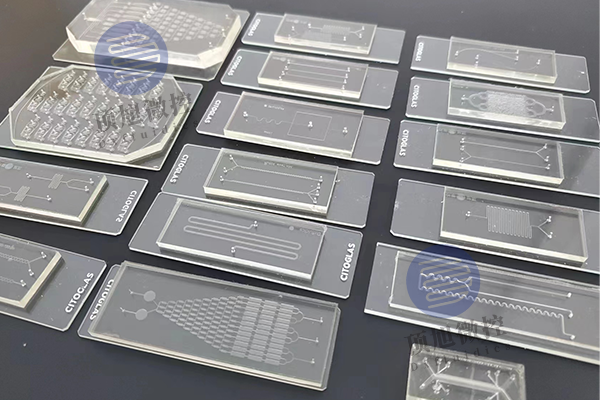
PDMS Material
PDMS, short for polydimethylsiloxane, is a common organic polymer used in the fabrication of prototypes for microfluidic chips. It possesses properties such as elasticity, transparency, breathability, and chemical inertness. PDMS is suitable for chip manufacturing applications related to cell culture, drug screening, and cell capture. Being inherently hydrophobic, its surface can be modified chemically or physically.
Advantages of PDMS Material:
• Optical Transparency: Excellent optical transparency of PDMS facilitates imaging and microscopy, allowing real-time imaging and monitoring of microfluidic cell culture chambers.
• Cost-Effective and Easy to Manufacture: The manufacturing process of PDMS microfluidic chips is standardized and straightforward. Additionally, PDMS can easily bond to form sealed channels, unlike thermoplastic materials.
• High Resolution and Fine Features: PDMS chips are typically fabricated by casting liquid pre-polymer on a master mold. This casting process can imprint the finest features (down to a few micrometers) on PDMS over a wide range of aspect ratios.
• Flexibility:With the advancement of microfluidic research, PDMS microchips are being employed in flexible electronics due to their inherent flexibility.
• Biologically Inert: PDMS is a biologically inert material, ensuring its neutrality in biological applications, making it a suitable choice for cell culture substrates.
• Adjustability: PDMS has a relatively low elastic modulus that can be easily adjusted by tuning the curing agent ratio, providing a wide range of material stiffness. There are also methods to adjust the electrical and thermal properties of PDMS microfluidic chips.
• Breathability: PDMS is a breathable material with an oxygen diffusion coefficient around 2000-4000 µm²/s and a carbon dioxide diffusion coefficient around 1000 µm²/s. This advantage makes PDMS preferable for long-term cell culture. However, this permeability can lead to non-specific absorption of hydrophobic small molecules into microfluidic channels.
Commonly Used PDMS Materials:
Two commonly used PDMS materials are RTV-615 by Momentive and Sylgard 184 by Dow Corning. The compositions of these materials are considered trade secrets. Based on experience, recommendations for selecting PDMS are as follows:
RTV-615 by Momentive:
1)Preferred for preparing microvalves.
2)Robust with strong bonding suitable for multilayer bonding of chips.
3)Prone to getting dirty.
Sylgard 184 by Dow Corning:
1)Relatively cleaner.
2)Suitable for single-layer bonding, not recommended for multilayer bonding.
3)Widely used in cell culture and organ-on-a-chip applications.
2 PDMS Chip Fabrication
PDMS chip fabrication employs soft lithography techniques,chip modelCopying reverse structures on silicon molds, SU8 molds, PFCT molds, acrylic molds, and metal molds allows for easy replication of features smaller than 0.1 micrometers. Simultaneously, through plasma surface treatment, PDMS can bond with PDMS itself, glass, and silicon, forming sealed channels.
2.1Mixing Glue:
PDMS glue is a two-component material consisting of A and B components. Using an electronic balance, the weight ratio is 10:(0.9~1). A larger ratio of A to B results in a softer gel after solidification.
2.2 Homogenization and Deaeration:
Mix A and B components thoroughly, place them in a vacuum desiccator, and let them sit in a vacuum for about 30 minutes to remove air bubbles.
2.3Pouring into Mold:
PDMS molding methods can use various molds such as silicon, SU8, Perfect, acrylic, or metal molds. After cleaning the mold, pour the PDMS into the mold and place it in an 85°C oven for 30 to 40 minutes.
2.4 Peeling:
Once the mold slightly cools, separate the cured microfluidic PDMS chip from the mold, taking care not to damage the mold or the microfluidic PDMS chip structure.
2.5 Cutting:
Use a specialized PDMS chip cutter or a craft knife to cut along the edges of the chip, ensuring neat edges.
2.6 Punching Holes:
Use a PDMS chip puncher to punch holes in the microfluidic PDMS chip and clean it with adhesive tape.
2.7 Bonding:
Treat the substrate (PDMS, glass) and the PDMS chip surface using a plasma cleaner. Bond with a power of 80-90W for 20-30 seconds (different plasma treatments may have variations in RF power and time). After treatment, bond within 30 seconds and place it in an 80°C oven for around 30 minutes.
Dxfluidics product ( standard PDMS chip)

Our company also provides customized microfluidic PDMS chip processing services. For specific details, please feel free to contact us at +86-17751163890 (also available on WeChat) or email:sale@dxfluidics.com.
| Product Code | Outline (mm) | Height (um) | Width (um) | Thickness (mm) | Chip material | Price (CNY) |
| K0001 | 45*20 | 50 | 50&100 | 3+1 | PDMS+Glass | 300 |
| K0002 | 45*20 | 50 | 80&100 | 3+1 | PDMS+Glass | 300 |
| K0003 | 45*20 | 50 | 50&100 | 3+1 | PDMS+Glass | 300 |
| K0004 | 45*20 | 50 | 100&300 | 3+1 | PDMS+Glass | 300 |
| K0005 | 45*20 | 50 | 50&100&150 | 3+1 | PDMS+Glass | 300 |
| K0006 | 45*20 | 50 | 100 | 3+1 | PDMS+Glass | 300 |
| K0007 | 75*25 | 100 | 100&300 | 3+1 | PDMS+Glass | 300 |
| K0008 | 52*25 | 100 | 100&150&200 | 3+1 | PDMS+Glass | 300 |
| K0009 | 35*24 | 100 | 100&200 | 3+1 | PDMS+Glass | 300 |
Ordering Methods



Site Search
Recommendations
© 2025. All Rights Reserved. 苏ICP备2022036544号-1















